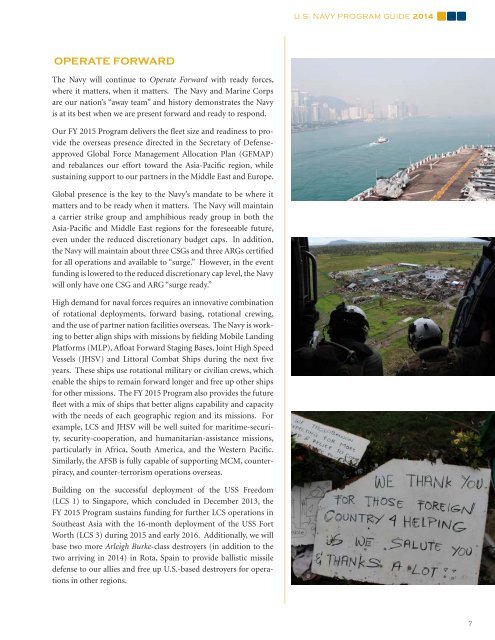NPG14_CHINFO_Web_7Mar14
NPG14_CHINFO_Web_7Mar14
NPG14_CHINFO_Web_7Mar14
You also want an ePaper? Increase the reach of your titles
YUMPU automatically turns print PDFs into web optimized ePapers that Google loves.
U.S. NAVY PROGRAM GUIDE 2014<br />
OPERATE FORWARD<br />
The Navy will continue to Operate Forward with ready forces,<br />
where it matters, when it matters. The Navy and Marine Corps<br />
are our nation’s “away team” and history demonstrates the Navy<br />
is at its best when we are present forward and ready to respond.<br />
Our FY 2015 Program delivers the fleet size and readiness to provide<br />
the overseas presence directed in the Secretary of Defenseapproved<br />
Global Force Management Allocation Plan (GFMAP)<br />
and rebalances our effort toward the Asia-Pacific region, while<br />
sustaining support to our partners in the Middle East and Europe.<br />
Global presence is the key to the Navy’s mandate to be where it<br />
matters and to be ready when it matters. The Navy will maintain<br />
a carrier strike group and amphibious ready group in both the<br />
Asia-Pacific and Middle East regions for the foreseeable future,<br />
even under the reduced discretionary budget caps. In addition,<br />
the Navy will maintain about three CSGs and three ARGs certified<br />
for all operations and available to “surge.” However, in the event<br />
funding is lowered to the reduced discretionary cap level, the Navy<br />
will only have one CSG and ARG “surge ready.”<br />
High demand for naval forces requires an innovative combination<br />
of rotational deployments, forward basing, rotational crewing,<br />
and the use of partner nation facilities overseas. The Navy is working<br />
to better align ships with missions by fielding Mobile Landing<br />
Platforms (MLP), Afloat Forward Staging Bases, Joint High Speed<br />
Vessels (JHSV) and Littoral Combat Ships during the next five<br />
years. These ships use rotational military or civilian crews, which<br />
enable the ships to remain forward longer and free up other ships<br />
for other missions. The FY 2015 Program also provides the future<br />
fleet with a mix of ships that better aligns capability and capacity<br />
with the needs of each geographic region and its missions. For<br />
example, LCS and JHSV will be well suited for maritime-security,<br />
security-cooperation, and humanitarian-assistance missions,<br />
particularly in Africa, South America, and the Western Pacific.<br />
Similarly, the AFSB is fully capable of supporting MCM, counterpiracy,<br />
and counter-terrorism operations overseas.<br />
Building on the successful deployment of the USS Freedom<br />
(LCS 1) to Singapore, which concluded in December 2013, the<br />
FY 2015 Program sustains funding for further LCS operations in<br />
Southeast Asia with the 16-month deployment of the USS Fort<br />
Worth (LCS 3) during 2015 and early 2016. Additionally, we will<br />
base two more Arleigh Burke-class destroyers (in addition to the<br />
two arriving in 2014) in Rota, Spain to provide ballistic missile<br />
defense to our allies and free up U.S.-based destroyers for operations<br />
in other regions.<br />
7








